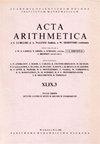不同椭圆曲线Cassels对的比较
IF 0.5
3区 数学
Q3 MATHEMATICS
引用次数: 0
摘要
本文章由计算机程序翻译,如有差异,请以英文原文为准。
On a comparison of Cassels pairings of different elliptic curves
Let $e_1,e_2,e_3$ be nonzero integers satisfying $e_1+e_2+e_3=0$. Let $(a,b,c)$ be a primitive triple of odd integers satisfying $e_1a^2+e_2b^2+e_3c^2=0$. Denote by $E: y^2=x(x-e_1)(x+e_2)$ and $\mathcal E: y^2=x(x-e_1a^2)(x+e_2b^2)$. Assume that the $2$-Selmer groups of $E$ and $\mathcal E$ are minimal. Let $n$ be a positive square-free odd integer, where the prime factors of $n$ are nonzero quadratic residues modulo each odd prime factor of $e_1e_2e_3abc$. Then under certain conditions, the $2$-Selmer group and the Cassels pairing of the quadratic twist $E^{(n)}$ coincide with those of $\mathcal E^{(n)}$. As a corollary, $E^{(n)}$ has Mordell-Weil rank zero without order $4$ element in its Shafarevich-Tate group, if and only if these holds for $\mathcal E^{(n)}$. We also give some applications for the congruent elliptic curve.
求助全文
通过发布文献求助,成功后即可免费获取论文全文。
去求助
来源期刊

Acta Arithmetica
数学-数学
CiteScore
1.00
自引率
14.30%
发文量
64
审稿时长
4-8 weeks
期刊介绍:
The journal publishes papers on the Theory of Numbers.
 求助内容:
求助内容: 应助结果提醒方式:
应助结果提醒方式:


